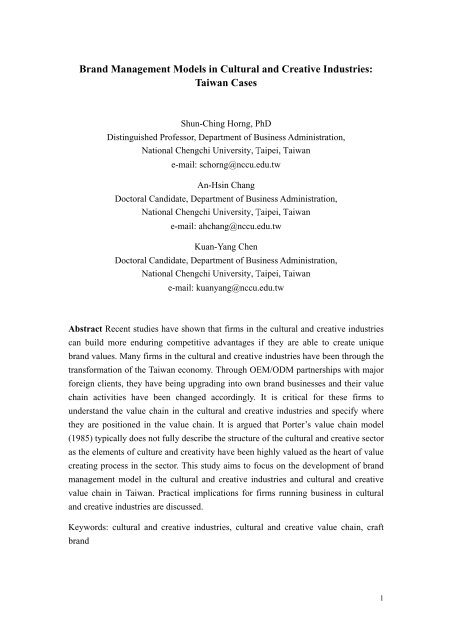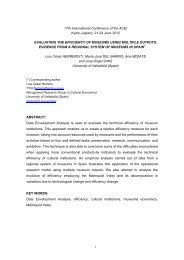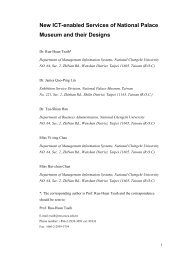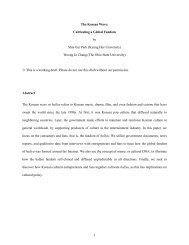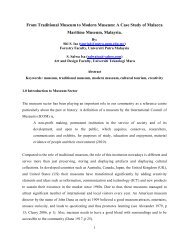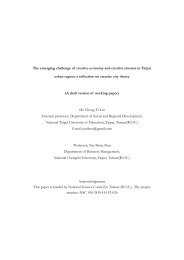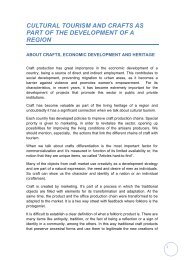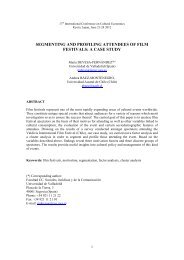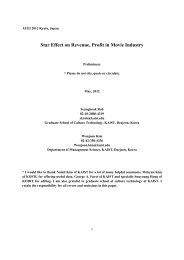Brand Management Models in Cultural and Creative Industries ...
Brand Management Models in Cultural and Creative Industries ...
Brand Management Models in Cultural and Creative Industries ...
Create successful ePaper yourself
Turn your PDF publications into a flip-book with our unique Google optimized e-Paper software.
<strong>Br<strong>and</strong></strong> <strong>Management</strong> <strong>Models</strong> <strong>in</strong> <strong>Cultural</strong> <strong>and</strong> <strong>Creative</strong> <strong>Industries</strong>:<br />
Taiwan Cases<br />
Shun-Ch<strong>in</strong>g Horng, PhD<br />
Dist<strong>in</strong>guished Professor, Department of Bus<strong>in</strong>ess Adm<strong>in</strong>istration,<br />
National Chengchi University, Taipei, Taiwan<br />
e-mail: schorng@nccu.edu.tw<br />
An-Hs<strong>in</strong> Chang<br />
Doctoral C<strong>and</strong>idate, Department of Bus<strong>in</strong>ess Adm<strong>in</strong>istration,<br />
National Chengchi University, Taipei, Taiwan<br />
e-mail: ahchang@nccu.edu.tw<br />
Kuan-Yang Chen<br />
Doctoral C<strong>and</strong>idate, Department of Bus<strong>in</strong>ess Adm<strong>in</strong>istration,<br />
National Chengchi University, Taipei, Taiwan<br />
e-mail: kuanyang@nccu.edu.tw<br />
Abstract Recent studies have shown that firms <strong>in</strong> the cultural <strong>and</strong> creative <strong>in</strong>dustries<br />
can build more endur<strong>in</strong>g competitive advantages if they are able to create unique<br />
br<strong>and</strong> values. Many firms <strong>in</strong> the cultural <strong>and</strong> creative <strong>in</strong>dustries have been through the<br />
transformation of the Taiwan economy. Through OEM/ODM partnerships with major<br />
foreign clients, they have be<strong>in</strong>g upgrad<strong>in</strong>g <strong>in</strong>to own br<strong>and</strong> bus<strong>in</strong>esses <strong>and</strong> their value<br />
cha<strong>in</strong> activities have been changed accord<strong>in</strong>gly. It is critical for these firms to<br />
underst<strong>and</strong> the value cha<strong>in</strong> <strong>in</strong> the cultural <strong>and</strong> creative <strong>in</strong>dustries <strong>and</strong> specify where<br />
they are positioned <strong>in</strong> the value cha<strong>in</strong>. It is argued that Porter’s value cha<strong>in</strong> model<br />
(1985) typically does not fully describe the structure of the cultural <strong>and</strong> creative sector<br />
as the elements of culture <strong>and</strong> creativity have been highly valued as the heart of value<br />
creat<strong>in</strong>g process <strong>in</strong> the sector. This study aims to focus on the development of br<strong>and</strong><br />
management model <strong>in</strong> the cultural <strong>and</strong> creative <strong>in</strong>dustries <strong>and</strong> cultural <strong>and</strong> creative<br />
value cha<strong>in</strong> <strong>in</strong> Taiwan. Practical implications for firms runn<strong>in</strong>g bus<strong>in</strong>ess <strong>in</strong> cultural<br />
<strong>and</strong> creative <strong>in</strong>dustries are discussed.<br />
Keywords: cultural <strong>and</strong> creative <strong>in</strong>dustries, cultural <strong>and</strong> creative value cha<strong>in</strong>, craft<br />
br<strong>and</strong><br />
1
Introduction<br />
In recent years, cultural <strong>and</strong> creative <strong>in</strong>dustries (hereafter referred to as CCIs) play<br />
an important part <strong>in</strong> the national development policies among developed <strong>and</strong><br />
develop<strong>in</strong>g countries (UNCTAD, 2008). Nations around the world have been putt<strong>in</strong>g<br />
effort to promote their CCIs. To follow this global economic trend, Taiwan<br />
government also has <strong>in</strong>vested significant time <strong>and</strong> resources to def<strong>in</strong>e <strong>and</strong> develop<br />
CCIs over last few years. In 2002, the government officially listed the CCIs <strong>in</strong>to the<br />
“Challenge 2008 National Development Plan” which would cost an estimated about<br />
US$75 billion. With this comprehensive six-year national development plan, Taiwan<br />
government expects to reach world class st<strong>and</strong>ard <strong>in</strong> products <strong>and</strong> technologies,<br />
stimulate the economy, encourage foreign <strong>in</strong>vestment <strong>and</strong> boost employment <strong>in</strong><br />
Taiwan (Government Information Office, 2002a). Accord<strong>in</strong>g to the figures from<br />
Taiwan Executive Yuan (the Cab<strong>in</strong>et), the sales revenues of CCIs <strong>in</strong>creased<br />
approximately US$56 billion from 2002 to 2007, <strong>and</strong> the value added of the <strong>in</strong>dustries<br />
<strong>in</strong>creased 1approximately US$29.8 billion, with an average of 7% growth per year<br />
(Taiwan Executive Yuan, 2009a).<br />
CCIs encompass various activities that <strong>in</strong>cludes the cultural <strong>in</strong>dustries with all<br />
cultural or artistic mode of production, whether live or produced as an <strong>in</strong>dividual unit<br />
(UNESCO Global Alliance for <strong>Cultural</strong> Diversity, 2006). CCIs are high <strong>in</strong> creativity<br />
nature <strong>and</strong> with potentials <strong>in</strong> economic development; however, how do the<br />
value-added activities actually work out still rema<strong>in</strong> unclear (Eikhof <strong>and</strong> Haunschild,<br />
2007). As the commercialization process <strong>in</strong> CCIs is dist<strong>in</strong>ct from manufactur<strong>in</strong>g<br />
bus<strong>in</strong>ess, past studies have emphasized the need for develop<strong>in</strong>g a bus<strong>in</strong>ess model<br />
concept to better articulate how values are created or added <strong>and</strong> for whom <strong>in</strong> the CCIs<br />
(Hartley, 2004; Taylor, 2006). Undoubtedly, Porter’s value cha<strong>in</strong> model is the most<br />
well-known model that has been used to analyze a firm’s value creation. The model<br />
was build with a production-oriented notion <strong>and</strong> a focus on the dynamics of<br />
<strong>in</strong>ter-connections with<strong>in</strong> the productive sector, <strong>and</strong> therefore it may not be completely<br />
applicable for cultural <strong>and</strong> creative bus<strong>in</strong>esses. The aims of this study were to develop<br />
the value cha<strong>in</strong> model of CCIs <strong>in</strong> Taiwan <strong>and</strong> to explore how do firms <strong>in</strong> this <strong>in</strong>dustry<br />
create value for their customers through a series of value creation activities.<br />
2
Theoretical backgrounds<br />
CCIs <strong>in</strong> Taiwan<br />
The orig<strong>in</strong>al concept of the CCIs can be referred to “those activities which have<br />
their orig<strong>in</strong> <strong>in</strong> <strong>in</strong>dividual creativity, skill <strong>and</strong> talent, <strong>and</strong> which have the potential for<br />
wealth <strong>and</strong> job creation through the generation <strong>and</strong> exploitation of <strong>in</strong>tellectual<br />
property” (DCMS, 1998). Accord<strong>in</strong>g to United Nations Educational, Scientific <strong>and</strong><br />
<strong>Cultural</strong> Organization (UNESCO, 2007), the concept of “cultural <strong>in</strong>dustries” centers<br />
around the cultural heritage <strong>and</strong> traditional <strong>and</strong> artistic elements of creativity, <strong>and</strong> the<br />
term “creative <strong>in</strong>dustries” tends to emphasize on <strong>in</strong>dividual creative talent <strong>and</strong><br />
<strong>in</strong>novation, <strong>and</strong> on the exploitation of <strong>in</strong>tellectual property.<br />
The Taiwan Council for <strong>Cultural</strong> Affairs proposed the concept of “Develop<strong>in</strong>g<br />
<strong>Cultural</strong> <strong>Industries</strong>, <strong>and</strong> Br<strong>in</strong>g<strong>in</strong>g Culture <strong>in</strong>to <strong>Industries</strong>” <strong>in</strong> 1995, <strong>and</strong> this “cultural<br />
<strong>in</strong>dustry” concept later has been put <strong>in</strong>to the national “Community Development”<br />
plan. With the trend of globalization <strong>and</strong> technological advancement, the government<br />
adapted a knowledge-based economy that focuses on “creativeness” <strong>and</strong> the<br />
ma<strong>in</strong>stream concept of “Th<strong>in</strong>k Globally, Act Locally” <strong>in</strong> the twenty-first century.<br />
“Challenge 2008 National Development Plan” published <strong>in</strong> 2002 prescribed that<br />
products with local cultural characteristics are expected to be developed through a<br />
comb<strong>in</strong>ation of art creativeness <strong>and</strong> commercial operations, which will not only<br />
deepen people’s cultural identities toward their own cultures but also <strong>in</strong>crease the<br />
added value for these <strong>in</strong>dustries (CCA, 2010). Under this national policy, thirteen<br />
sub-sectors are def<strong>in</strong>ed as Taiwan’s CCIs , <strong>in</strong>clud<strong>in</strong>g: visual arts <strong>in</strong>dustry, music <strong>and</strong><br />
perform<strong>in</strong>g arts <strong>in</strong>dustry, cultural exhibition facilities <strong>in</strong>dustry, h<strong>and</strong>icrafts <strong>in</strong>dustry,<br />
film <strong>in</strong>dustry, broadcast<strong>in</strong>g <strong>in</strong>dustry, publish<strong>in</strong>g <strong>in</strong>dustry, advertis<strong>in</strong>g <strong>in</strong>dustry, design<br />
<strong>in</strong>dustry, designer br<strong>and</strong> <strong>and</strong> fashion <strong>in</strong>dustry, architectural design <strong>in</strong>dustry, <strong>in</strong>novative<br />
lifestyle <strong>in</strong>dustry, digital leisure <strong>and</strong> enterta<strong>in</strong>ment <strong>in</strong>dustry (CEPD, 2002).<br />
CCIs <strong>in</strong> Taiwan are def<strong>in</strong>ed as <strong>in</strong>dustries that are “orig<strong>in</strong>ated from creative or<br />
cultural accumulation <strong>and</strong> has the potential of creat<strong>in</strong>g wealth <strong>and</strong> jobs <strong>and</strong> improv<strong>in</strong>g<br />
the liv<strong>in</strong>g environment by develop<strong>in</strong>g <strong>and</strong> deploy<strong>in</strong>g the <strong>in</strong>tellectual property” (Hsiao<br />
et al., 2010). Under the concept of “<strong>in</strong>dustrialization of culture” <strong>and</strong> “culturalization<br />
of <strong>in</strong>dustry” proposed by Taiwan’s government (Wu, 2003), many entrepreneurs <strong>and</strong><br />
enterprises have transformed their bus<strong>in</strong>esses <strong>in</strong>to the creative <strong>and</strong> cultural fields. As<br />
CCIs <strong>in</strong> Taiwan face strong competition from regional neighbor countries <strong>in</strong> recent<br />
years (UNCTAD, 2004), the promotion of the concept of “culture <strong>in</strong>dustrialization,<br />
<strong>in</strong>dustries culturalization” aims to identify <strong>and</strong> realize the economic value of local<br />
cultural assets through the process of commercialization <strong>and</strong> enhance competitiveness<br />
3
of local cultural <strong>and</strong> creative firms through an appreciation <strong>and</strong> application of the<br />
essence of Taiwan’s history <strong>and</strong> culture (Chung, 2012).<br />
Economic development <strong>in</strong> Taiwan<br />
Taiwan’s economic strength started with commodity <strong>and</strong> labor-<strong>in</strong>tensive<br />
<strong>in</strong>dustries <strong>in</strong> 1960s. S<strong>in</strong>ce the mid 1980s, the economy has been rapidly restructured<br />
<strong>and</strong> shifted from production of labor-<strong>in</strong>tensive goods to less labor-<strong>in</strong>tensive service<br />
(Government Information Office, 2002b). Many firms <strong>in</strong> the CCIs have been through<br />
a series of transformation of the Taiwan economy. After decades of serv<strong>in</strong>g as<br />
OEM/ODM suppliers, the value activities of these firms have been reconfigured <strong>and</strong><br />
core competences have been changed accord<strong>in</strong>gly. Some of these firms have<br />
committed to achiev<strong>in</strong>g transform<strong>in</strong>g <strong>in</strong>to br<strong>and</strong>-name companies by seek<strong>in</strong>g<br />
emerg<strong>in</strong>g opportunities <strong>in</strong> cultural <strong>and</strong> creative market <strong>and</strong> creat<strong>in</strong>g strong br<strong>and</strong>s of<br />
great creativity <strong>and</strong> design capabilities. Today, nearly 90% of all cultural <strong>and</strong> creative<br />
bus<strong>in</strong>esses <strong>in</strong> Taiwan are operated as sole proprietorships or micro-enterprises <strong>and</strong>, as<br />
such, are entirely different <strong>in</strong> nature from other types of bus<strong>in</strong>esses (Taiwan Executive<br />
Yuan, 2009b).<br />
In fact, most cultural <strong>and</strong> creative bus<strong>in</strong>ess owners or entrepreneurs may identify<br />
themselves as artists <strong>and</strong> designers rather than bus<strong>in</strong>ess people. Their devotion to<br />
work is often driven by cultural or creative factors rather than economic ones. S<strong>in</strong>ce it<br />
is wildly believed that “<strong>Creative</strong> people tend to rebel at efforts to manage them overly<br />
systematically”(Florida, 2002), commercialization of creativity <strong>and</strong> artistic motivation<br />
management may run risk of damag<strong>in</strong>g these resources (Eikhof <strong>and</strong> Haunschild,<br />
2007). Although there is a basic conflict <strong>in</strong>herent <strong>in</strong> the nature of creativity/art <strong>and</strong><br />
bus<strong>in</strong>ess/management (Eikhof <strong>and</strong> Haunschild, 2007), cultural <strong>and</strong> creative<br />
entrepreneurs need to develop <strong>and</strong> <strong>in</strong>tegrate both creative <strong>and</strong> bus<strong>in</strong>ess skills to be<br />
competitive <strong>and</strong> susta<strong>in</strong>able <strong>in</strong> today’s marketplace.<br />
Value cha<strong>in</strong> <strong>in</strong> CCIs<br />
Porter def<strong>in</strong>ed the value cha<strong>in</strong> (hereafter referred to as VC) as a “framework for<br />
identify<strong>in</strong>g all these activities <strong>and</strong> analyz<strong>in</strong>g how they affect both a company's costs<br />
<strong>and</strong> the value delivered to buyers” (Porter, 2001). At one end the process of shift<strong>in</strong>g<br />
goods are orig<strong>in</strong>ation <strong>and</strong> the producer; <strong>in</strong> the middle the commodity <strong>and</strong> its<br />
distribution; at toward the other end is the consumer or end user (Hartley, 2004).<br />
Porter’s value cha<strong>in</strong> model (1985) consists of primary activities (<strong>in</strong>bound logistics,<br />
4
operations, outbound logistics, market<strong>in</strong>g <strong>and</strong> sales, <strong>and</strong> service) <strong>and</strong> support<br />
activities the firm marshals to create values (<strong>in</strong>frastructure, human resource<br />
management, technology development, <strong>and</strong> procurement).<br />
However, there are several limitations when apply<strong>in</strong>g Porter’s model to the CCIs.<br />
First, the CCIs may not fit easily <strong>in</strong>to the conventional value cha<strong>in</strong> model as they<br />
share many characteristics of the service economy (Potts, Cunn<strong>in</strong>gham, Hartley <strong>and</strong><br />
Ormerod, 2008). Value cha<strong>in</strong> model is logical for firms that produce tangible products,<br />
such as cars or consumer electronics that require physical <strong>in</strong>puts <strong>and</strong> large <strong>in</strong>vestment<br />
for production capacity <strong>and</strong> raw materials, but service oriented firms rely more on<br />
human assets as the primary ways for value creation (Cartwright <strong>and</strong> Oliver, 2000).<br />
Furthermore, the conventional VC cannot capture the complexity of roles <strong>and</strong><br />
relationships <strong>in</strong> the CCIs. <strong>Cultural</strong> goods are practical examples of the hybrid <strong>and</strong><br />
complex relationships between production <strong>and</strong> consumption, the symbolic mean<strong>in</strong>gs<br />
<strong>and</strong> materials (Pratt, 2008). O’Connor (2010) argued that “technological reproduction<br />
is necessary but not sufficient to expla<strong>in</strong> the expansion of cultural commodity<br />
production”. Pratt (2008) further elaborated that “front l<strong>in</strong>e” artists or cultural workers<br />
are often seen as only ones who create value; however the <strong>in</strong>ter-relationships of the<br />
whole production cha<strong>in</strong>, <strong>and</strong> its ways that it is variously embedded <strong>in</strong> space also need<br />
to be appreciated. One of the most important po<strong>in</strong>ts is that the CCIs <strong>in</strong>volve higher<br />
value-added <strong>in</strong>puts (i.e., digital contents, knowledge <strong>and</strong> skills) <strong>in</strong> the upstream<br />
activities of the VC, <strong>and</strong> this is where they take their part <strong>in</strong> the knowledge-based<br />
economy (Cunn<strong>in</strong>gham, 2002).<br />
Methodology<br />
This study attempts to explore the characteristics of VC <strong>in</strong> Taiwan’s CCIs <strong>and</strong><br />
underst<strong>and</strong> how the two dist<strong>in</strong>ct elements, creativity <strong>and</strong> bus<strong>in</strong>ess, actually <strong>in</strong>fluence<br />
creative production. Rather than probability sampl<strong>in</strong>g, the aim of the study was to<br />
explore the variation of issues across the samples (Weiss, 1994). A discovery-oriented<br />
approach was adopted to conduct secondary data analysis <strong>and</strong> <strong>in</strong>-depth <strong>in</strong>terviews.<br />
The sampled enterprises are representative cases of the observed phenomenon; these<br />
enterprises are successful <strong>in</strong>novators <strong>and</strong> have successfully pursued own-br<strong>and</strong><br />
strategies <strong>in</strong> their respective sectors <strong>in</strong> CCIs. Due to the range <strong>and</strong> diversity of<br />
different sectors with<strong>in</strong> CCIs, these sectors have very diverse <strong>in</strong>dustrial traits.<br />
Therefore, this study focuses on craft sector only, as craft sector is also one of those<br />
<strong>in</strong>dustries which has high economic value <strong>and</strong> possesses strong cultural connotations<br />
(UNESCO, 2000).<br />
5
Craft <strong>in</strong>dustry is def<strong>in</strong>ed as one of the CCIs <strong>in</strong> Taiwan <strong>and</strong> is essential to the<br />
economy. Crafts <strong>in</strong> Taiwan are dynamic <strong>and</strong> diverse. Local crafts <strong>in</strong> Taiwan were<br />
made accord<strong>in</strong>g to daily needs of people, climate, natural environment, culture,<br />
history <strong>and</strong> religion (NCTA, 2012). Though many traditional crafts <strong>in</strong> Taiwan are<br />
orig<strong>in</strong>ated from the M<strong>in</strong>g or Ch<strong>in</strong>g Dynasty of Ch<strong>in</strong>a, from Kenton <strong>and</strong> Fujen areas <strong>in</strong><br />
Ch<strong>in</strong>a, because of the <strong>in</strong>fluence of the local aborig<strong>in</strong>e crafts, Japanese arts,<br />
<strong>in</strong>dustrialized thoughts, <strong>and</strong> western ideas, they have evolved from history <strong>and</strong><br />
developed their own features (NTCRI, 2001).<br />
Today, several award-w<strong>in</strong>n<strong>in</strong>g craft bus<strong>in</strong>esses emerged, such as “FRANZ” <strong>and</strong><br />
“tittot”, they have become successful <strong>in</strong>ternational br<strong>and</strong>s. This study adopted an<br />
exploratory-oriented approach <strong>and</strong> multiple-case method. Company cases were<br />
chosen based on their pursuit of own-br<strong>and</strong> strategies, sales <strong>and</strong> profitability.<br />
Considerable documentary <strong>in</strong>formation was gathered from cultural <strong>and</strong> creative<br />
enterprises to enable the triangulation of emerg<strong>in</strong>g themes.<br />
F<strong>in</strong>d<strong>in</strong>gs <strong>and</strong> Discussion<br />
This study characterizes three bus<strong>in</strong>ess models <strong>in</strong> which they are posited <strong>in</strong> five<br />
key components of the value creation process: culture, ideation, design, production,<br />
<strong>and</strong> market<strong>in</strong>g (<strong>in</strong>clud<strong>in</strong>g br<strong>and</strong><strong>in</strong>g <strong>and</strong> channel). Due to unique characteristics of<br />
CCIs, first two components (design <strong>and</strong> production) are considered as fundamental<br />
elements <strong>and</strong> serve as the accelerator of core value for craft products. The VC <strong>in</strong> this<br />
study is called the “culture creative-based value cha<strong>in</strong> (hereafter referred to as CCVC)<br />
(Figure 1).<br />
Values<br />
Figure 1: Culture <strong>Creative</strong>-Based Value Cha<strong>in</strong><br />
6
The value cha<strong>in</strong> <strong>in</strong> craft <strong>in</strong>dustry beg<strong>in</strong>s from “digg<strong>in</strong>g” culture which provides<br />
symbolic mean<strong>in</strong>gs to our daily lives. <strong>Cultural</strong> products carry a symbolic value which<br />
is determ<strong>in</strong>ed by the social <strong>and</strong> cultural mean<strong>in</strong>gs associated with it <strong>and</strong> this allows<br />
consumers to express <strong>in</strong>dividual <strong>and</strong> social identity via the purchase <strong>and</strong> use of the<br />
products (Ravasi <strong>and</strong> R<strong>in</strong>dova, 2008). <strong>Cultural</strong> context serves <strong>in</strong>put for the process of<br />
ideas generation, which is the <strong>in</strong>itial moment <strong>and</strong> forum of creativity <strong>and</strong> can be<br />
carried out either <strong>in</strong> non-formal <strong>and</strong> <strong>in</strong>formal sett<strong>in</strong>gs (Mercer, 2002). There is a large<br />
usage of oriental cultural elements, especially Ch<strong>in</strong>ese culture <strong>in</strong> the creation of<br />
cultural <strong>and</strong> creative products <strong>in</strong> Taiwan, as well as the process of <strong>in</strong>corporat<strong>in</strong>g local<br />
Taiwanese culture, Western <strong>in</strong>fluences <strong>and</strong> modern technologies. Crafts are not only<br />
made by h<strong>and</strong> with traditional craft methods, but are also made with specialized<br />
equipments.<br />
Next, cultural product design is a process of reth<strong>in</strong>k<strong>in</strong>g or review<strong>in</strong>g cultural<br />
features, <strong>and</strong> a new product is designed through redef<strong>in</strong><strong>in</strong>g cultural features of current<br />
products. Dur<strong>in</strong>g the design stage, culture serves as a source of <strong>in</strong>novation <strong>and</strong><br />
creativity <strong>and</strong> both practical use <strong>and</strong> the aesthetic qualities of products are highly<br />
considered. Production is about the transformation of ideas <strong>in</strong>to cultural goods <strong>and</strong><br />
services <strong>and</strong> it deals people, resources, productive capacities <strong>and</strong> tra<strong>in</strong><strong>in</strong>g available to<br />
aid the transformation of ideas <strong>in</strong>to marketable products (L<strong>and</strong>ry, 2000). Due to the<br />
limitation of supply <strong>and</strong> customer’s requirements of mass customization, overseas<br />
production has become a common practice <strong>in</strong> Taiwan. Although these observed craft<br />
br<strong>and</strong>s moved their production bases <strong>in</strong>to Ch<strong>in</strong>a <strong>and</strong> other countries, the production of<br />
unique <strong>and</strong> premium products as well as their R&D <strong>and</strong> design center is ma<strong>in</strong>ly<br />
located <strong>in</strong> Taiwan.<br />
These chosen craft bus<strong>in</strong>esses have long been noticed of the power of br<strong>and</strong><br />
value, br<strong>and</strong>-build<strong>in</strong>g had been an ambition s<strong>in</strong>ce the firm was established. Bus<strong>in</strong>ess<br />
owners, who possess artist or craftsman background, are lack of management <strong>and</strong><br />
bus<strong>in</strong>ess skills to run the bus<strong>in</strong>ess. A firm may choose to specialize <strong>in</strong> one or more<br />
value cha<strong>in</strong> activities <strong>and</strong> outsource the rest. The extent to which a firm performs<br />
upstream <strong>and</strong> downstream activities is decided by its level of vertical <strong>in</strong>tegration.<br />
“Tittot” is a f<strong>in</strong>e craft br<strong>and</strong> <strong>in</strong> Taiwan, engaged <strong>in</strong> the crystal glass design,<br />
process<strong>in</strong>g, produc<strong>in</strong>g <strong>and</strong> sale of glass craft products <strong>and</strong> accessories. In 1994, the<br />
two brothers, Yuan-Shan Wang <strong>and</strong> He<strong>in</strong>rich Wang together established tittot.<br />
He<strong>in</strong>rich Wang stated that artists usually focus on creat<strong>in</strong>g artworks <strong>and</strong> do not have<br />
much of an idea about or energy left for production, management <strong>and</strong> market<strong>in</strong>g <strong>and</strong><br />
therefore br<strong>and</strong> management needs to rely on bus<strong>in</strong>ess professionals (GIO, 2009).<br />
Artists normally shun entrepreneurship have stereotypic ideas of artists (Kamara,<br />
7
2004), it is important to match artistic expertise with knowledge of bus<strong>in</strong>ess, though<br />
not necessarily with<strong>in</strong> same person (Pratt, 2008). Tittot has its own R&D <strong>and</strong> br<strong>and</strong><br />
management teams. He<strong>in</strong>rich Wang is the company's creative director, specializes <strong>in</strong><br />
an ancient glassmak<strong>in</strong>g technique called “lost wax cast<strong>in</strong>g” <strong>and</strong> also has been<br />
design<strong>in</strong>g <strong>and</strong> produc<strong>in</strong>g glass artwork while explor<strong>in</strong>g new glassmak<strong>in</strong>g techniques<br />
over the years (GIO, 2004). His work has been collected by museums around the<br />
world s<strong>in</strong>ce the early 1990s. On the other h<strong>and</strong>, professional management <strong>and</strong><br />
market<strong>in</strong>g activities are directed by his brother Yung-Shan Wang, who has years of<br />
experience <strong>in</strong> bus<strong>in</strong>ess management (GIO, 2009).<br />
“Artilize Worldwide” is a good example of collaborative work among artists,<br />
designers <strong>and</strong> entrepreneurs. Artilize Worldwide, a market<strong>in</strong>g firm which focuses on<br />
promot<strong>in</strong>g cultural <strong>and</strong> creative products. The ma<strong>in</strong> bus<strong>in</strong>ess activities <strong>in</strong>cluded<br />
<strong>in</strong>ternational market<strong>in</strong>g of art items, design <strong>and</strong> copyright for art items, <strong>and</strong> art<br />
advertis<strong>in</strong>g (MEA, 2011). “Tales by Pave” is the company’s craft product l<strong>in</strong>e of<br />
decorative art tiles. These tiles are created <strong>in</strong> square <strong>and</strong> rectangle ornamental stone<br />
decopaves that are illustrated with ancient myths <strong>and</strong> stories (Artilize Worldwide,<br />
2008). Successfully collaborat<strong>in</strong>g of its design <strong>and</strong> production outsourc<strong>in</strong>g partners<br />
enables the company to build up br<strong>and</strong> new bus<strong>in</strong>ess models with art <strong>and</strong> creative<br />
products.<br />
“FRANZ” designs, creates <strong>and</strong> markets a variety of functional <strong>and</strong> home decor<br />
accessories. The collection <strong>in</strong>cludes porcela<strong>in</strong> tableware, vases <strong>and</strong> decorative accents,<br />
as well as a l<strong>in</strong>e of exquisite jewelry (Franz, 2012). Franz Porcela<strong>in</strong> is well-known for<br />
its harmonic balance of Ch<strong>in</strong>ese f<strong>in</strong>e porcela<strong>in</strong> crafts with styl<strong>in</strong>g <strong>in</strong>spired by classic<br />
Art Nouveau designs. FRANZ’s parent company, Seagull Décor, has more than two<br />
decades experience as premiums <strong>and</strong> gifts manufacturer. The achievement of the<br />
br<strong>and</strong> is largely contributed to the company’s management of market knowledge,<br />
recruitment of talented porcela<strong>in</strong> makers <strong>and</strong> designers, advanced technology <strong>and</strong> the<br />
capability of establish<strong>in</strong>g sales channels. FRANZ’s dist<strong>in</strong>ctiveness is built on a high<br />
level of vertical <strong>in</strong>tegration <strong>and</strong> attempts to create value at different VC activities. It is<br />
notable that a young br<strong>and</strong> like FRANZ (founded <strong>in</strong> 2002), actively attend<strong>in</strong>g<br />
<strong>in</strong>ternational exhibitions <strong>and</strong> trade shows <strong>and</strong> accumulat<strong>in</strong>g awards is a crucial way to<br />
maximize br<strong>and</strong> exposure <strong>and</strong> attracts attention from potential customers overseas.<br />
8
VC Unit<br />
Model<br />
Model 1:<br />
Craftsman/<br />
Designer<br />
br<strong>and</strong>s<br />
Company <strong>and</strong><br />
br<strong>and</strong> name:<br />
“Tittot”<br />
Model 2:<br />
Company<br />
with<br />
market<strong>in</strong>g<br />
competence<br />
Company:<br />
“Artilize<br />
worldwide”<br />
(<strong>Br<strong>and</strong></strong> name:<br />
Tales by Pave).<br />
Model 3:<br />
vertically<br />
diversified<br />
company<br />
Company <strong>and</strong><br />
br<strong>and</strong> name:<br />
“FRANZ”<br />
Table 1: Bus<strong>in</strong>ess models drawn from CCVC<br />
Culture Ideation Design Production<br />
Products<br />
convey the<br />
Ch<strong>in</strong>ese way<br />
of th<strong>in</strong>k<strong>in</strong>g<br />
<strong>and</strong> liv<strong>in</strong>g.<br />
<strong>Br<strong>and</strong></strong> stories<br />
are derived<br />
from<br />
traditional<br />
oriental<br />
culture, such<br />
as Ch<strong>in</strong>ese<br />
culture <strong>and</strong><br />
Indian culture.<br />
Blend<strong>in</strong>g the<br />
essence of<br />
oriental<br />
culture with<br />
the styl<strong>in</strong>g<br />
<strong>in</strong>spired by<br />
Western<br />
artistry.<br />
Us<strong>in</strong>g<br />
Ch<strong>in</strong>ese<br />
philosophies<br />
to deepen the<br />
creations<br />
profundity.<br />
Stone carv<strong>in</strong>g<br />
of legendary<br />
stories <strong>and</strong><br />
historic<br />
objects on<br />
square <strong>and</strong><br />
rectangle<br />
ornamental<br />
stone deco<br />
paves.<br />
Comb<strong>in</strong><strong>in</strong>g<br />
traditional<br />
Ch<strong>in</strong>ese<br />
character<br />
with classic<br />
art nouveau<br />
designs to<br />
create more<br />
various<br />
styles.<br />
�In-house<br />
craftsman <strong>and</strong><br />
designers.<br />
�Integrat<strong>in</strong>g<br />
Ch<strong>in</strong>ese<br />
culture to<br />
perform unique<br />
lost-wax<br />
cast<strong>in</strong>g.<br />
�Collaborat<strong>in</strong>g<br />
with local<br />
designers <strong>and</strong><br />
artists <strong>in</strong> Asian<br />
countries.<br />
�Design<br />
elements are<br />
dawn from<br />
symbolic<br />
patterns <strong>and</strong><br />
architectural<br />
elements.<br />
�In-house<br />
Porcela<strong>in</strong><br />
craftsman <strong>and</strong><br />
designers<br />
�Design<br />
themes are<br />
<strong>in</strong>spired by<br />
nature, <strong>and</strong><br />
through the<br />
designer's<br />
<strong>in</strong>terpretation<br />
of the oriental<br />
philosophy.<br />
Mass-produced<br />
commodity<br />
made <strong>in</strong> Ch<strong>in</strong>a,<br />
<strong>and</strong> high-end<br />
pieces<br />
produced <strong>in</strong><br />
Taiwan.<br />
�Us<strong>in</strong>g of local<br />
raw materials.<br />
�Outsourc<strong>in</strong>g<br />
manufactur<strong>in</strong>g<br />
to collaborat<strong>in</strong>g<br />
production<br />
sites.<br />
�Design <strong>and</strong><br />
research center<br />
is based <strong>in</strong><br />
Taiwan.<br />
�Mass<br />
production<br />
carefully<br />
managed <strong>and</strong><br />
closely<br />
supervised <strong>in</strong><br />
Ch<strong>in</strong>a.<br />
Market<strong>in</strong>g<br />
<strong>Br<strong>and</strong></strong><strong>in</strong>g Channel<br />
Founder,<br />
He<strong>in</strong>rich Wang a<br />
well-known film<br />
director <strong>and</strong> is<br />
devoted to the<br />
development of<br />
Ch<strong>in</strong>ese crystal<br />
glass<br />
craftsmanship.<br />
The br<strong>and</strong> is<br />
owned <strong>and</strong><br />
managed by<br />
“Artilize<br />
Worldwide”.<br />
This br<strong>and</strong><br />
def<strong>in</strong>es itself as<br />
a smart <strong>and</strong><br />
modern player<br />
of transform<strong>in</strong>g<br />
art to life.<br />
�Integrat<strong>in</strong>g<br />
Eastern<br />
aesthetics <strong>and</strong><br />
Western art<br />
nouveau style<br />
� A br<strong>and</strong><br />
captures<br />
<strong>in</strong>ternational<br />
fame for its<br />
decorative,<br />
functional arts<br />
<strong>and</strong> crafts.<br />
�Items are<br />
sold <strong>in</strong><br />
high-end<br />
department<br />
stores.<br />
�Products<br />
distributed to<br />
more than 80<br />
specialized<br />
counters.<br />
The collection<br />
now are<br />
distributed <strong>in</strong><br />
30 countries<br />
with over 450<br />
shops.<br />
�Items are<br />
sold<br />
worldwide to<br />
prestigious<br />
department<br />
stores.<br />
�Over 6,000<br />
po<strong>in</strong>t of sales<br />
over the<br />
world.<br />
9
Conclusions<br />
Taiwan has successfully executed export-oriented development strategy to drive<br />
up economic growth; however the economic performance of Taiwan’s craft goods <strong>in</strong><br />
the global market still lag beh<strong>in</strong>d other countries <strong>in</strong> the same region (CCIPT, 2008).<br />
Firms <strong>in</strong> CCIs can develop more endur<strong>in</strong>g competitive advantages if they are able to<br />
create unique br<strong>and</strong> values. It is critical for these firms to underst<strong>and</strong> the value cha<strong>in</strong><br />
<strong>in</strong> CCIs <strong>and</strong> assess their positions <strong>in</strong> the value cha<strong>in</strong>. We attempt to depict the value<br />
cha<strong>in</strong> of CCIs <strong>in</strong> Taiwan us<strong>in</strong>g craft sector as an example. Many firms <strong>in</strong> CCIs have<br />
been through the transform<strong>in</strong>g OEM/ODM bus<strong>in</strong>ess model <strong>in</strong>to OBM, the value<br />
activities of these firms have been reconfigured <strong>and</strong> core competences have been<br />
changed accord<strong>in</strong>gly. Therefore, <strong>in</strong> the follow<strong>in</strong>g phase, this research will adopt field<br />
<strong>in</strong>vestigations <strong>and</strong> <strong>in</strong>terviews with more representative CCIs cases from different<br />
sectors to <strong>in</strong>crease the generalizability of the study. This research will cont<strong>in</strong>ue to<br />
identify the key success factors to br<strong>and</strong> management <strong>in</strong> CCIs <strong>and</strong> also <strong>in</strong>vestigate the<br />
dynamic process of value reposition<strong>in</strong>g <strong>and</strong> reconfiguration of value activity among<br />
cultural <strong>and</strong> creative firms. Another attempt is to identify strategic groups of these<br />
firms that adopted similar value configurations <strong>and</strong> growth path.<br />
References<br />
Artilize Worldwide (2008). Decopaves Inspired by Asian Culture <strong>and</strong> Arts. Available<br />
at: www.artilize.com (Accessed: May/17/2012)<br />
Cartwright, S. D., <strong>and</strong> Oliver, R. (2000). Untangl<strong>in</strong>g the Value Web. Journal of<br />
Bus<strong>in</strong>ess Strategy, 21 (1): 22-28.<br />
Council for <strong>Cultural</strong> Affairs (CCA) (2009). <strong>Creative</strong> Taiwan —2009-2013 <strong>Cultural</strong> &<br />
<strong>Creative</strong> <strong>Industries</strong> Development Plan. Available at:<br />
http://www.CCIs.org.tw/CCIs/upload/law/20100604104150-8dd3d038610f19c0<br />
bd08739c496f4052.pdf (Accessed: March/17/2012).<br />
<strong>Cultural</strong> <strong>and</strong> <strong>Creative</strong> <strong>Industries</strong> Promotion Team (CCISPT) (2009). 2008 Taiwan<br />
<strong>Cultural</strong> & <strong>Creative</strong> <strong>Industries</strong> annual Report. Taipei: Taiwan Industrial<br />
Development Bureau, M<strong>in</strong>istry of Economics Affairs.<br />
Chung, H. (2012). Reboot<strong>in</strong>g the Dragon at the Cross-roads? Divergence or<br />
Convergence of <strong>Cultural</strong> Policy <strong>in</strong> Taiwan. International Journal of <strong>Cultural</strong><br />
Policy, 18(3): 340-355.<br />
10
Council of Economic Plann<strong>in</strong>g <strong>and</strong> Development (2002). Challenge 2008: The<br />
Six-year National Development Plan. Available at:<br />
http://www.gio.gov.tw/taiwan-website/4-oa/20020521/2002052101.html<br />
(accessed May/05/2012).<br />
Cunn<strong>in</strong>gham, S. D. (2002). From <strong>Cultural</strong> to <strong>Creative</strong> <strong>Industries</strong>: Theory, Industry,<br />
<strong>and</strong> Policy Implications. Media International Australia Incorporat<strong>in</strong>g Culture<br />
<strong>and</strong> Policy: Quarterly Journal of Media Research <strong>and</strong> Resources, (102): 54-65.<br />
Department of Culture, Media <strong>and</strong> Sport (1998). <strong>Creative</strong> <strong>Industries</strong> Mapp<strong>in</strong>g<br />
Document. London: DCMS.<br />
Eikhof, D. <strong>and</strong> Haunschild, A. (2007). For Art’s Sake! Artistic <strong>and</strong> Economic Logics<br />
<strong>in</strong> <strong>Creative</strong> Production. Journal of Organizational Behaviour, (28): 523-538.<br />
Florida, R. (2002). The Rise of the <strong>Creative</strong> Class: <strong>and</strong> How It’s Transform<strong>in</strong>g Work,<br />
Leisure, Community <strong>and</strong> Everyday Life. New York: Basic Books.<br />
FRANZ (2012). About Franz. Available at: www.franzcollection.com (accessed<br />
May/01/2012).<br />
Galloway, S., <strong>and</strong> Dunlop, S. (2007). A Critique of Def<strong>in</strong>itions of the <strong>Cultural</strong> <strong>and</strong><br />
<strong>Creative</strong> <strong>Industries</strong> <strong>in</strong> Public Policy. International Journal of <strong>Cultural</strong> Policy,<br />
13(1): 17-32.<br />
Government Information Office (GIO) (2002a). Green Silicon Isl<strong>and</strong>. Available at:<br />
http://www.gio.gov.tw/taiwan-website/ad/w<strong>in</strong>/012/html/silicon.htm (accessed<br />
May/01/2012).<br />
Government Information Office (GIO) (2002b). Challenge 2008 the Six-year National<br />
Development Plan. Available at:<br />
http://www.gio.gov.tw/taiwan-website/4-oa/20020521/2002052101.html<br />
(accessed May/01/2012).<br />
Government Information Office (GIO) (2004). Brother team sees future of glass<br />
bus<strong>in</strong>ess half full. Available at:<br />
http://www.taiwantoday.tw/ct.asp?xItem=20487&CtNode=122 (accessed<br />
May/07/2012).<br />
Government Information Office (GIO) (2009). In Culture We Trust. Available at:<br />
http://taiwantoday.tw/ct.asp?xItem=59426&CtNode=124 (accessed<br />
May/08/2012).<br />
Hartley, J. (2004). The "Value Cha<strong>in</strong> of Mean<strong>in</strong>g" <strong>and</strong> the New Economy.<br />
International Journal of <strong>Cultural</strong> Studies, 7(1): 129-141.<br />
11
Hsiao, S., Wang, P., Chiu, C. Chung, G., Peng, K., <strong>and</strong> Shih, M. (2010). A Study of<br />
L<strong>in</strong>kage Analysis on the <strong>Cultural</strong> <strong>and</strong> <strong>Creative</strong> <strong>Industries</strong>. International Journal<br />
of Information Process<strong>in</strong>g <strong>and</strong> <strong>Management</strong>, 1(2): 133-139.<br />
Kamara, Y. (2004). Keys to successful cultural enterprise development <strong>in</strong> develop<strong>in</strong>g<br />
countries, Division of Arts <strong>and</strong> <strong>Cultural</strong> Enterprise, UNESCO. Available at:<br />
http://portal.unesco.org/culture/en/ev.php-URL_ID=25436&URL_DO=DO_TO<br />
PIC&URL_SECTION=201.html (accessed May/05/2012).<br />
L<strong>and</strong>ry, C. (2000). The <strong>Creative</strong> City. London: Earthscan.<br />
Mercer, C. (2002). Towards <strong>Cultural</strong> Citizenship: Tools for <strong>Cultural</strong> Policy<br />
Development. Stockholm: Bank of Sweden.<br />
M<strong>in</strong>istry of Economic Affairs (MEA) (2011). One Town One Product - Story page.<br />
Available at: otop.tw/storypage.php?id=106190 (accessed May/01/2012).<br />
National Center for Traditional Art (NCTA) (2012). Introduction to Traditional Art.<br />
Available at: http://www.ncfta.gov.tw/ncfta_eh/e01/<strong>in</strong>dex.aspx (accessed<br />
May/01/2012).<br />
National Taiwan Craft Research <strong>and</strong> Development Institute (NTCRI ) (2001). 2001<br />
The First National Crafts Awards. Available<br />
at: http://www2.ntcri.gov.tw/ncp1/1stnca/Page01.htm (accessed May/01/2012).<br />
O’Connor, J. (2010). The <strong>Cultural</strong> <strong>and</strong> <strong>Creative</strong> <strong>Industries</strong>: A Literature Review (2nd<br />
ed.). Newcastle: Creativity, Culture <strong>and</strong> Education.<br />
Porter, M. E. (2001). Strategy <strong>and</strong> the Internet. Harvard Bus<strong>in</strong>ess Review, 79(3):<br />
62-78.<br />
Porter, M. E. (1985). Competitive Advantage: Creat<strong>in</strong>g <strong>and</strong> Susta<strong>in</strong><strong>in</strong>g Superior<br />
Performance. New York: The Free Press.<br />
Potts, J., Cunn<strong>in</strong>gham, S., Hartley, J. <strong>and</strong> Ormerod, P. (2008). Social Network<br />
Markets: A New Def<strong>in</strong>ition of the <strong>Creative</strong> <strong>Industries</strong>. Journal of <strong>Cultural</strong><br />
Economics, 32(3): 167-185.<br />
Pratt, C. (2008). <strong>Creative</strong> cities: the cultural <strong>in</strong>dustries <strong>and</strong> the creative class.<br />
Geografiska Annaler: Series B - Human geography, 90 (2): 107-117.<br />
Ravasi, D., <strong>and</strong> R<strong>in</strong>dova, V. (2008). Symbolic Value Creation. In Barry, D. <strong>and</strong><br />
Hansen, H. (eds.), H<strong>and</strong>book of New Approaches to Organization. London: Sage<br />
Publications.<br />
12
Taiwan Executive Yuan (2009). <strong>Cultural</strong> <strong>and</strong> <strong>Creative</strong> <strong>Industries</strong>: New Eng<strong>in</strong>e for<br />
Wider Economic Growth. Available at:<br />
http://www.ey.gov.tw/ct.asp?xItem=64011&ctNode=1334&mp=1 (accessed<br />
May/05/2012).<br />
Taiwan Executive Yuan (2009). <strong>Creative</strong> Taiwan: <strong>Cultural</strong> <strong>and</strong> creative <strong>in</strong>dustry<br />
development plan. Available at:<br />
http://www.ey.gov.tw/ct.asp?xItem=63679&ctNode=2907&mp=1 (accessed<br />
May/05/2012).<br />
Taylor, C. (2006). Beyond Advocacy: Develop<strong>in</strong>g an Evidence Base for Regional<br />
<strong>Creative</strong> Industry Strategies. <strong>Cultural</strong> Trends, 15(1): 3–18.<br />
United Nations Conference on Trade <strong>and</strong> Development (UNCTAD) (2008). <strong>Creative</strong><br />
economy report 2008: the Challenge of Assess<strong>in</strong>g the <strong>Creative</strong> Economy<br />
towards Informed Policy-mak<strong>in</strong>g. Available at:<br />
http://www.unctad.org/Templates/Webflyer.asp?<strong>in</strong>tItemID=4494 (accessed<br />
May/02/2011).<br />
United Nations Conference on Trade <strong>and</strong> Development (UNCTAD) (2004). <strong>Creative</strong><br />
<strong>Industries</strong> <strong>and</strong> Development. Available at:<br />
http://www.unctad.org/en/docs/tdxibpd13_en.pdf (accessed May/02/2011).<br />
United Nations Educational, Scientific <strong>and</strong> <strong>Cultural</strong> Organization (UNESCO) (2000).<br />
World Culture Report: <strong>Cultural</strong> Diversity, Conflict <strong>and</strong> Pluralism. Paris:<br />
UNESCO Publish<strong>in</strong>g.<br />
United Nations Educational, Scientific <strong>and</strong> <strong>Cultural</strong> Organization (UNESCO) (2007).<br />
<strong>Cultural</strong> <strong>Industries</strong> <strong>in</strong> Asia <strong>and</strong> the Pacific. Available at:<br />
http://www.unescobkk.org/culture/cultural_<strong>in</strong>dustries (accessed Feb/17/2010).<br />
UNESCO Global Alliance for <strong>Cultural</strong> Diversity (2006). Underst<strong>and</strong><strong>in</strong>g <strong>Creative</strong><br />
<strong>Industries</strong>: <strong>Cultural</strong> Statistics for Public-Policy Mak<strong>in</strong>g. Available at:<br />
http://portal.unesco.org/culture/en/files/30297/11942616973cultural_stat_EN.pd<br />
f/cultural_stat_EN.pdf (accessed May/06/2012).<br />
Weiss, R. S. (1994). Learn<strong>in</strong>g from Strangers: The Art <strong>and</strong> Method of Qualitative<br />
Interview Studies. New York: The Free Press.<br />
Wu, M. C. (2003). To Implement <strong>Cultural</strong> <strong>and</strong> <strong>Creative</strong> Industry Development Plan.<br />
Bimonthly Journal for Research, Development <strong>and</strong> Evaluation, 27(4): 59-65.<br />
13


